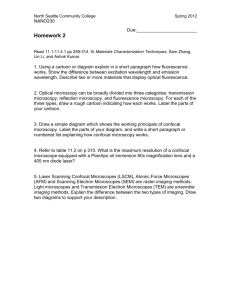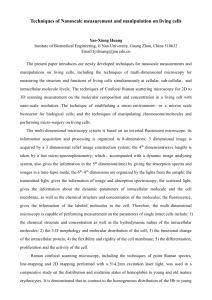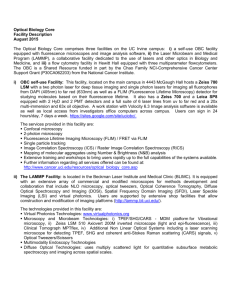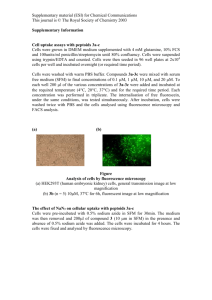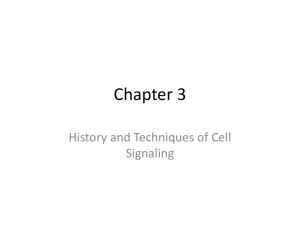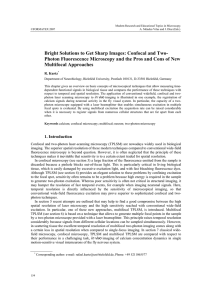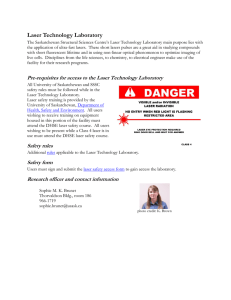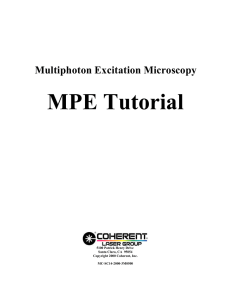Document
advertisement
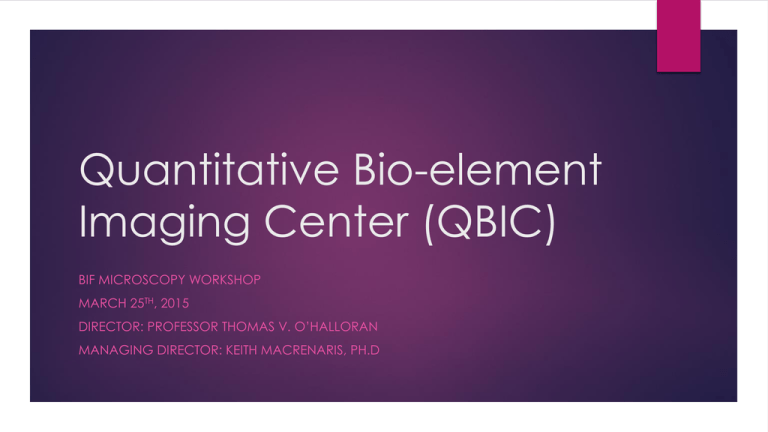
Quantitative Bio-element Imaging Center (QBIC) BIF MICROSCOPY WORKSHOP MARCH 25TH, 2015 DIRECTOR: PROFESSOR THOMAS V. O’HALLORAN MANAGING DIRECTOR: KEITH MACRENARIS, PH.D History and Mission of CLP and QBIC “The Chemistry of Life Processes Institute acts as an umbrella for a variety of centers, facilitates collaborations and helps bridge different cultures. By lowering the barriers to scientific discovery, the Institute hopes, for example, to design new drugs for the treatment of cancer and neurodegenerative diseases as well as develop improved techniques for diagnosing diseases earlier.” Designed to be a collaborative, interdisciplinary effort to map the “inorganic signatures of life” Started in 2003 and established as an official center within the Chemistry of Life Processes Institute in September of 2008 CLP includes 39 tenure-track faculty members and 11 cores and centers Elemental Analysis is located in Silverman Hall East Room B540 Microscopy is located in Silverman Hall East room Organization of Imaging Facilities within CLP How to Map the Inorganic Signatures of Life Elemental Analysis Imaging Collaboration Using high end instrumentation for quantitative metal analysis to determine metal concentrations in solutions, materials, cells and tissues. Using one-of-a-kind STEM, 2-photon laser scanning microscopy, and laser ablation ICP-MS for elemental mapping in tissues and cells The synergy with Argonne National Laboratory and the Advanced Photon Source for Hard X-ray Fluorescence Microscopy for subcellular trace elemental mapping QBIC Space in Silverman Hall 1571 Upright Confocal Microscopy Meta Detector Objective Turret First instrument installed was Upright Confocal microscope in 2003 with manual tunable spectra physics 2-photon laser Zeiss LSM 510 Upright Confocal Microscope Equipped with Argon (488 nm), 2 HeNe (545, 633 nm) continuous wave lasers Beginning in September 2008 a softwaretunable Spectra physics MaiTai DeepSee Ti:Sapphire 2-photon Laser Equipped with a tunable Meta Detector for multi-wavelength and spectrum analysis capabilities Short working distance high N.A. objectives [10x, 20x, 40x, 100x (oil)] as well as a 63x, 0.9 N.A. dipping lens Two-Photon Excitation Phenomena Simultaneous absorption of two photons in order to excite a molecule from a ground state (usually) to an excited electronic state. Generally uses a femtosecond-pulsed solid state near IR laser such as Ti:Sapphire du to low probability of nearsimultaneous absorption of two photons hence the need for high flux. With two photons absorbed simultaneously the probability of fluorescence emission increases quadratic ally with excitation intensity. This restricts excitation to a small focal volume (~ 1 femtoliter) Advantages: Minimal phototoxicty and sample damage due to the use of NIR-IR light, increased penetration depth (up to 1.5 mm), and tunable excitation wavelength increasing the library of usable fluorophores for laser scanning microscopy. Major disadvantage: Tendency to produce heat due to plasmonic excitation in nanoparticles particularly gold. Emission Ratiometric Imaging of Intracellular Zinc Excitation @ 710 nm using 2-photon laser No treatment + 10 µM zinc sulfate J. Am. Chem. Soc., 2004, 126 (3), pp 712–713 + 1 mM TPEN Inverted Confocal Microscopy Zeiss AxioObserver.Z1 Inverted confocal microscope with LSM 510 Installed in September of 2008 with software-tunable Spectra physics MaiTai DeepSee Ti:Sapphire 2-photon Laser Equipped with Argon (488 nm), 2 HeNe (545, 633 nm) continuous wave lasers Equipped with 3 PMT detectors and Discovery V8 Pentafluor & stage top incubation Short working distance high N.A. objectives [10x, 20x, 40x, 63x (oil)] X-Cite Fluorescence Illumination System and DIC optics for 20x and 40x objectives Nanoparticle Imaging using Confocal Microscopy (Left) A fluorescence micrograph of Gold nanostars (AuNS) loaded with high densities of nucleolin-specific DNA aptamer (Apt-AuNS). (Right) Fluorescence micrographs of 6 different cancer cell lines incubated with Apt-NS. (Odom Group, Chemistry) Mouse (SKH1-E) skin treated topically with 1∶1 Aquaphor only (Left) or with 50 nM Cy5-labeled (red) SNA-NCs dispersed in the 1∶1 Aquaphor (Right). (Paller Group, Dermatology) Microinjection/Micromanipulation Olympus IX53 Inverted microscope installed June 2014 10x, 20x, and 40x long working distance Hoffman printed objectives for high resolution imaging in plastic Equipped with an Eppendorf Transferman NK2 microinjection system, including a Warner Instruments Picoliter Injection System Equipped with a Color CCD camera for image acquisition and analysis Computer workstation with CellSens Software High Speed Fluorescence Microscopy Olympus IX83 Inverted Fluorescence Microscope installed June 2014 Motorized z-stage with zero drift compensation Equipped with a 30 fps ANDOR Zyla sCMOS camera with 5.5 megapixel format and 22 mm field of view Long working distance DIC/Phase condenser (N.A. 0.55, W.D. 27 mm) 2.5x, 10x, 20x, and 60x (oil) long working distance objectives Motorized fluorescence turret with filters for DAPI/FITC/TRITC/Cy5 CCD versus CMOS Both convert photons of light into electric charge and process it into electric signals Charge Coupled Devices (CCDs) every pixels charge is transferred through a limited number of output nodes and sent off as an analog signal Complementary Metal Oxide Semiconductors (CMOS) is designed to have every pixel to have its own charge to voltage conversion and includes amplifiers, noise correction, and digitization circuits where the chips output is in digital bits Generally, CCDs have lower noise and more uniformity with better signal CMOS cameras have very high frame rates Laser Ablation ICP-MS STEM/EDS in NUANCE Information For Microscopy and LA-ICP-MS email: Keith MacRenaris at keithmacrenaris2009@u.northwestern.edu For STEM/EDS analysis email: Reiner Bleher at bleherreiner@gmail.com QBIC website: http://qbic.facilities.northwestern.edu/ NUANCE website: http://www.nuance.northwestern.edu/
